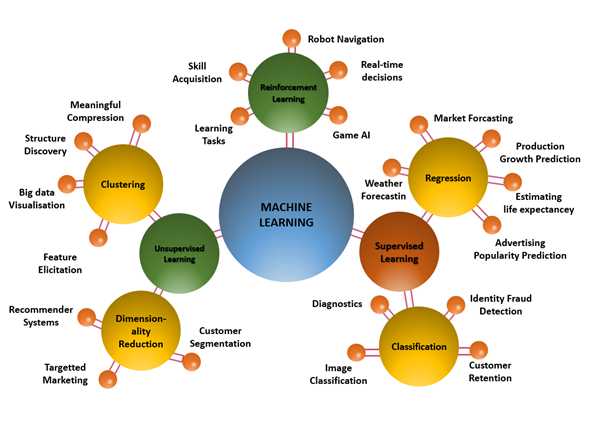Getting started with machine learning
Machine learning is a fascinating field to study, and for good reason. In today’s world, it is all around us. Machine learning is used in almost every aspect of our lives, from Facebook’s news feed to Google Maps for navigation. It’s both terrifying and fascinating to consider how our lives would have turned out if machine learning hadn’t been invented. As a result, it’s critical to understand what machine learning is, how it works, and why it’s important. However, before we can answer these questions, we must first understand the history of machine learning.
A brief history of machine learning
You might think that machine learning is a relatively new topic, but it wasn’t until 1950 that the concept of machine learning was introduced, when Alan Turing published a paper in response to the question “Can machines think?”.
Frank Rosenblatt created the first computer neural network in 1957, which is now known as the Perceptron Model. Bernard Widrow and Marcian Hoff created two neural network models in 1959, Adeline and Madeline, that could detect binary patterns and eliminate echo on phone lines, respectively.
The Nearest Neighbor Algorithm, developed in 1967, allowed computers to perform very basic pattern recognition.
In 1981, Gerald DeJonge proposed the concept of explanation-based learning, in which a computer analyzes data and develops a general rule to eliminate irrelevant data.
Machine learning research shifted from a knowledge-driven to a data-driven approach in the 1990s. During this time, scientists began developing computer programs that could analyze large amounts of data and draw conclusions or “learn” from the findings. Which eventually evolved into the modern era of machine learning after several developments.
What is machine learning?
Machine learning is the study of artificial intelligent computer algorithms that improve automatically over time by the application of analytics and also by experience. It is often viewed as a sub-field of AI, itself. It is a data analysis approach that automates the development of analytical models. In other terms, it is the branch of computer science that enables a machine to learn on its own without being explicitly programmed. These algorithms learn, change, and grow on their own when exposed to new data.
So, instead of writing the code for each new problem, you simply feed the data to the ML algorithm, which builds the logic and provides results based on the given data.
How do machine learning algorithms work?
Machine learning algorithms use a variety of techniques to make decisions based on large amounts of complex data. With specific inputs provided to the machine, these algorithms complete the task of learning from data. It all starts with creating a model by training the machine learning algorithm with a training data set. The ML algorithm creates a prediction when new input data is introduced. The accuracy of the forecasts and outcomes is assessed.
If the forecast does not turn out as expected, the algorithm is retrained until it produces the intended result. This allows the ML algorithm to train on its own and offer the best possible answer, which will improve in accuracy over time. After a desirable degree of accuracy is attained, the machine learning algorithm is then deployed.

Methods of machine learning:
There are several approaches to machine learning. However, we will focus on the more dominant methods.
Supervised learning, often known as supervised machine learning, is an artificial intelligence and machine learning subcategory, which relies solely on the use of labeled datasets to train algorithms that accurately classify data or predict outcomes. As input data is fed into the model, the weights are adjusted until the model is properly fitted, which happens during the cross validation phase. A training set is used in supervised learning to teach models to produce the desired output. This training dataset contains both correct and incorrect outputs, allowing the model to improve over time. The loss function is used to assess the algorithm’s accuracy, and it is adjusted until the error is sufficiently minimized. When it comes to data mining, supervised learning can be divided into two types: classification and regression
Unsupervised learning is used against data that has no historical labels. Here, the “right answer” is never given to the computer. The algorithm is responsible for determining what is displayed. The goal is to sift over the data and determine if there is any kind of structure. On transactional data, unsupervised learning performs effectively. It can, for example, identify consumer groups with similar traits so that similar marketing initiatives can be targeted. It can also check for key traits that differentiate distinct client groups.
Reinforcement machine learning algorithms
Reinforcement machine learning algorithms are a type of learning algorithm that interact with its surroundings by generating actions and detecting failures or rewards. The most important elements of reinforcement learning are trial and error search and delayed reward. This technology enables machines and software agents to automatically select the best behavior in a given situation in order to improve efficiency.

How different is machine learning from AI?
Artificial intelligence and machine learning are two popular buzzwords which are frequently used interchangeably even though they are not exactly the same. It is however not surprising that both terms come up frequently when it comes to big data, analytics, and the broader waves of technological change that are sweeping the world.
Simply put, AI refers to machines’ ability to perform tasks in a manner that we would consider “smart”, while machine learning is a current AI application based on the idea that we should be able to simply give machines data and let them learn on their own.
Why is machine learning so important?
The era we find ourselves in, necessitate competitive business performance, which may not be possible to achieve only through human efforts. As such, the need for humans to be able to train machines for them to execute certain tasks is vital. Increased data volume and variety, cheaper and more efficient computational processing, and low-cost data storage are only but a few outcomes of such processes. An organization’s chances of finding profitable opportunities–or preventing unseen threats –are improved by developing precise models. As a business leader, you do not want to make the mistake of making educated guesses about your data. This can be quite expensive for your business in terms of money and time. To construct models that allow for exact prediction, you must rely on machine learning.
Industries that use machine learning
Many institutions are now implementing ML in their daily processes due to the multiple benefits it provides. For instance, financial services are now using ML for two major reasons, one, to identify important insights in data, and two, to prevent fraud. These insights can help to identify investment opportunities. Data mining may also be used to classify clients with a high-risk profile, cyber monitoring, on the other hand, can be utilized to spot fraud warning signs.
Due to the arrival of wearable gadgets and sensors that may use data to estimate a patient’s health in real time, machine learning is a rapidly expanding trend in the health-care business. Some health monitors, which monitor your heart rate and sleep patterns, can help you notice any abnormalities in your health to avoid an emergency.
Medical practitioners can use the technology to examine data and spot trends that could lead to better diagnosis and treatments.
Moreover, in the transportation industry, which relies on making routes more efficient and detecting future difficulties to boost profitability, analyzing data to detect patterns and trends is also critical. The data processing and modeling capabilities of machine learning are useful tools for delivery companies, public transit networks, and other transportation businesses.
In addition, government agencies, such as public safety and utilities, have a particular need for machine learning since they have numerous sources of data that can be mined for insights. Sensor data, for example, can be used to find cost-cutting opportunities, fraud detection and identity theft prevention.
The vast manufacturing industry is also no stranger to machine learning. Machine learning applications in manufacturing are aimed at improving operations from conception to delivery, lowering error rates, improving predictive maintenance, and increasing inventory turn.
Finally, machine learning and artificial intelligence are already being used to find new energy sources, analyze mineral deposits in the ground, predict refinery sensor failure, and streamline oil distribution to increase efficiency and lower costs. Oil distribution is being streamlined to make it more efficient and cost-effective. The number of machine learning application use cases is enormous — and still expanding – across various industries. So, one may ask…. Is all the hullabaloo over machine learning really warranted? The answer is ‘Yes’, according to many experts interviewed during a Scalework Research, but with one caveat: knowing how to apply it to the unique challenges and goals of each industry.
Arrange an appointment with our data experts to assess your data science readiness.





